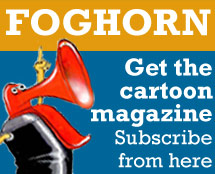
PCOer Adrian Teal (click to enlarge his Daniel Craig drawing, above) discusses the neglected art of the caricaturist:
If press cartoonists are feeling neglected, press caricaturists are feeling doubly so. The PCO is pursuing an admirable policy of singing the praises of the cartoon to anyone who’ll listen. The highly specialized trade of caricature is even more threatened, however, and I humbly submit that this noble profession should be given equal standing in the campaign.
Perhaps it’s the caricaturists’ fault. The standard (and standing) of British caricature has been in steep decline since the press lost interest in it after Spitting Image’s demise, and really good caricature is hard to find these days. Unless we can show the world how potent the art form can be, we will perish, and deservedly so.
When faced with something humorous and visceral, people often overlook the care and thought which has gone into a drawing. To a large extent – and I know I’m treading on a few corns here – cartoons are the fast-food of journalism; enjoyed briefly, and then discarded. But good caricatures have a staying power, which is lacking in pocket cartoons. They usually do not have the luxury of a caption to help them along. And the sheer amount of work which goes into them can be out of all proportion to the attention (and fees) they are given.
It is this kind of attention to detail, and plain hard slog, which marks the caricaturist out as the sturdy, muscular workhorse of cartooning, and I urge the PCO to help the journalistic world recognize his worth.
Thanks to Adrian Teal. Bloghorn says: Click T for Teal
UPDATED 28th April 2008: Some responses to Adrian’s opinion can be found in the comments section immediately under this edit
More British cartoon talent
So Long, and thanks for all the fish…
7 years ago






2 comments:
Speaking as a cartoonist born without an an ounce of natural caricaturing talent in his veins – and, as such, one with no axe to grind – I have to say I am astonished by the minimal use that the UK press makes of caricature.
In a celeb-obsessed medium, whether swooning at the feet of, or gleefully digging and spreading the dirt on (often both at the same time) those famous for being famous, you have to say that editors are missing a valuable trick. A good caricature is both a shrewdly observed illustration and a wickedly pointed comment all wrapped up in one – an editor's dream, you would think.
And that's before we even get started on politicians where, if a picture is worth a thousand words, a good caricature is worth ten thousand.
Posted on behalf of PCOer Andy Davey:
To a certain extent I agree, Adrian. There has been a decline since the ubiquitous portrait caricature in every magazine - everywhere from Radio Times to the New York Review of Books. Caricature has suffered the same fate as drawn illustration – death by photograph. I would dearly love us to have the power to reverse that trend. I love the “humbled” art form and could pore over the great work of the Vanity Fair “celebrity” caricatures from the 20s, 30s and 40s (Covarrubias, Frueh, Garretto, Hirschfeld) or Gerald Scarfe’s stunning work of the 60s for days on end. Why has it been so humbled? First, I think the loss of cap-doffing servility in our society since the fifties has resulted in a cruder tone to the media; it is unlikely that a caricature can shock now, even in the way it did in the 1960s of Scarfe. The power to shock was a pretty useful tool in the caricaturist’s arsenal way back when. Second, caricature may have contributed to its own strangulation too. The inexorable rise of on-the-spot caricatures as party entertainment has cheapened the form. Drawing a 5-minute (or less) caricature is a clever party trick, but leaves the impression that all caricature is simply that – a “comedy sketch”. Thirdly, the internet has given everyone with access to a Wacom board the chance to show that he/she is a caricaturist – leading to a great ocean of mediocrity. To make something special of a caricature portrait, I think the artist has to do more than simply get a likeness. He/she must either show some interesting abstraction like the “cubism” of David Cowles or incorporate some clever “editorial” trope (e.g. Noma Bar’s construction of faces from appropriate props) which makes him/her stand out from the mass. Great artwork is still being done in this genre, even after Sebastian Kruger has moved onward and upward – you can see some of the very best (Kruger, John Ireland, David Cowles, Joan Vizcarra, Noma Bar, Zack Trenholm etc.) at the Shrewsbury Museum and Gallery until the end of the month in an exhibition called “Art About Face”. But there is simply so much dross around. It is sometimes difficult to spot a gem in the mud. Faced with so much mediocrity, is it any wonder that the whole art form is getting a rather tarnished reputation? I say all the above with no axe-grinding intention – aside from my attempts at editorial cartoon, where the ability to caricature is simply another tool in the box, I scrape a living drawing caricature – both in the press and reluctantly as an on-the-spot “comedy sketch artist” [entertainment agency nomenclature – not mine]. Unfortunately, this makes me a “pantomime horse” of cartooning, rather than your “muscular workhorse”, but I take your point. You say that “unless we can show the world how potent the art form can be, we will perish, and deservedly so.” I quite agree – in fact that’s pretty much what we wrote in the blurb for the “Art About Face” exhibition. It’s down to us to make some stunning work for its own sake – and show it off.
Post a Comment